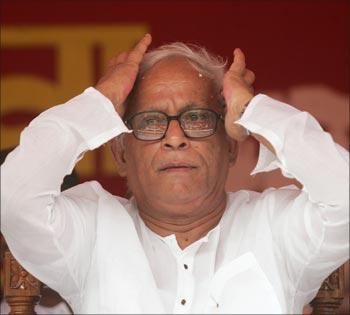
At his maiden press conference after being sworn in as the chief minister for the second time, a beaming Buddhadeb Bhattacharjee asked reporters, "How do you like the beginning?"
The beginning he was referring to was the Nano project in Singur, the announcement of which coincided with his swearing-in ceremony.
The 'beginning' was as dramatic as the end and the irony of it all sums up Bhattacharjee's track record as he stepped into the 10th year of his chief ministership early this month.
Industry still admires his no-nonsense approach, but even his best friends now say the chief minister lost the plot somewhere along the way.
Now consider the mistakes. . . further. . .
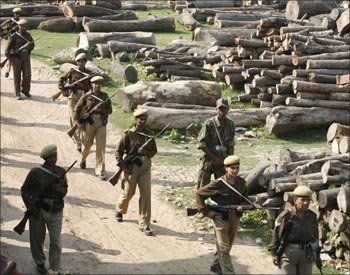
The beginning of what many now see a possible end to the long Marxist rule in the state started in Nandigram, about 150 km from Kolkata. An unspecified number of people, ranging from 14 to 50, were killed on March 14, 2007, in a police firing ordered by the West Bengal government -- a colossal blunder.
About 4,000 policemen were ordered into Nandigram to fight a turf war that had rendered hundreds of CPI(M) supporters homeless, as the Trinamool Congress and Naxalites took up cudgels against acquisition of 14,000 acres for a chemical special economic zone (SEZ) to be developed by Indonesia's Salim group and NRI industrialist Prasoon Mukherjee displacing about 36 villages.
When the firing took place, the state government had already put off the project from Nandigram, but it brought to the fore the perils of industrialisation in a lush green Bengal, where fallow land is 1 per cent.
That was perhaps the first time Bhattacharjee realised that he was fighting a losing battle for industrialisation in Bengal.
With only 23,000 acres vested with the government of a total agricultural land of 1,350 million acres, it's a nigh impossible task.

Nandigram also meant the return of Mamata Banerjee, Trinamool Congress chief and now railway minister, who was decimated in the Assembly elections of 2006.
One mistake followed the other. As the public memory of Nandigram started fading, Singur -- the Tata Motors site for Nano project -- erupted.
Dissent had been brewing immediately after the project was announced in 2006 and much before the police firing at Nandigram but was first made famous by the 26-hour hunger strike by Banerjee.
Singur, fertile enough to grow three to four crops, reared its head after the Panchayat polls, with the erosion of the Left Front base and the government often having to resort to Section 144.
Having shunned a consultative approach from the very beginning, the government could not convince the less than 20 per cent of the unwilling land losers that the project would translate into uplift for them.
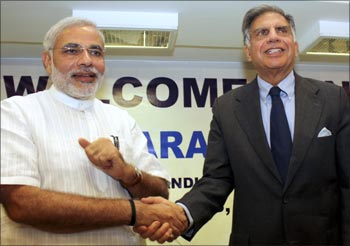
The agitation continued, Banerjee was allowed to carry on an indefinite siege. The dharna and the Tata Motors site got almost equal protection from the police, pushed into cynical resignation since Nandigram.
Eventually Tata Motors pulled out and went to Sanand in Gujarat.
Since then the Left Front has done miserably in the recent Lok Sabha elections and the bypolls.
Everyone is baffled by the turn of events as Bhattacharjee, who was brought in as chief minister in 2000 to rejuvenate the image of the party, address the flight of capital and joblessness, started rather well.
It was change indeed. Bhattacharjee thought big and was in a rush to bring about radical changes in Bengal. He blacklisted the word gherao and often fought with the Left Front allies for the sake of industry.
Consider this: Bhattacharjee used his veto powers last year to renew the APMC licence to German wholesaler, Metro Cash & Carry, as the Forward Bloc, part of the Left Front, refused to do so.
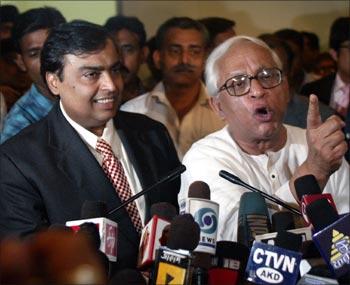
In the first five years of chief ministership, Bhattacharjee focused on the services sector. He got Wipro and hoped for Infosys, while TCS expanded. Azim Premji thought he was the best chief minister, Ratan Tata reposed full faith in Bhattacharjee and brought Nano to Bengal from Uttarakhand.
There were quite a few other success stories as well. JSW Steel's 10 million tonne steel project is probably the only mega steel project to have the land, mines and all clearances including SEZ status.
Not surpisingly, Sajjan Jindal, vice chairman and managing director, JSW Steel, says, "My experience in West Bengal has been very good and positive. It is as if all the people want this project to be successful and are prepared to do his or her bit."
There are ten proposed steel plants in the private sector involving an investment of Rs 1,09,550 crore (Rs 1,095.50 billion), of which two projects have land, while the rest are in different stages of land acquisition.
Bhattacharjee also recently stepped in to allocate land to Wipro and Infosys. Both the companies were earlier offered land at an IT township called Kolkata Links located near a spa resort called Vedic Village which erupted in controversy, involving the state government as well.
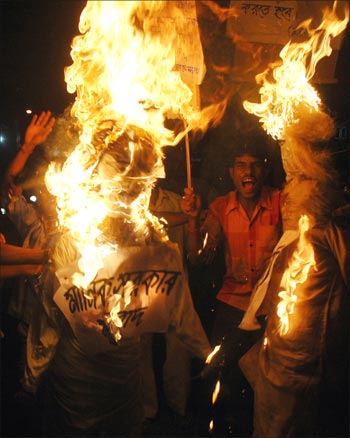
Observers say though the chief minister's intentions are good, he does not know how to handle the potential problems arising out of the highly emotive issue of land acquisition from farmers and allowed things to drift.
"If Bhattacharjee's initiatives have received a jolt, so have the reforms planned by the party, though the hardliners relegated to the backseat have found their voice," they said.
Under Operation Barga (that handed over land to small cultivators and share-croppers), two million landless labourers were given land by the state government. But that probably is posing as one of the biggest obstacles to industrialisation, as the state government failed miserably in taking the poor along with its vision.
The chief minister is now trying to make up and has started making trips to districts every weekend to oversee development work.
The frequency of those trips would have to increase if Bhattacharjee hopes to come back to Writers' Buildings (the centre of power in the state) for a fresh beginning.